Intrepid Overview
Commander’s Log: The meteor shower prediction was worse than we thought. Our multinational crew took the forecast better than expected. The German was stoic, the Russian fatalistic, and the American a bit too cavalier. We barely had time to prepare, but all is not lost. If we think fast and pull together, we will survive.
In Intrepid (2-4 players, cooperative, 90 min) you play the roles of astronauts from different nations serving on the International Space Station who must keep the spacecraft (and themselves) alive during a deadly meteor shower. The theme evokes international cooperation, interstellar tech, and intense problem solving. When you take in all the gadgets, the four system panels, and the asymmetric special abilities for each different country, Intrepid reveals itself to be a delightfully immersive experience.
Setup & Game Play
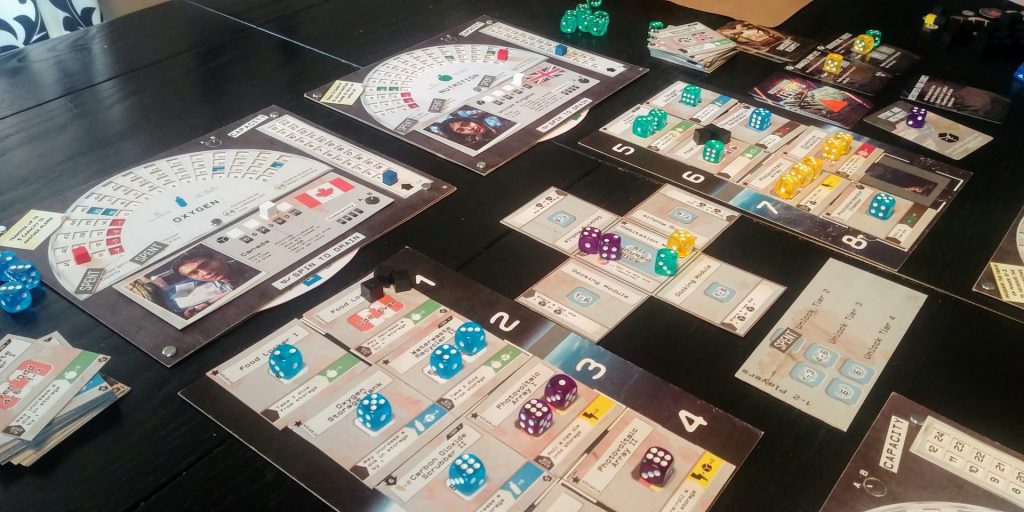
Even though Intrepid plays between 2 and 4 players, the game setup requires that all four stations – Climate, Nutrition, Oxygen, and Power – are active. Because of the prolonged COVID-19 quarantine, I was only able to play the game with 2 players while the other player remotely participated on video chat. We each controlled two nations. I can also confirm that, while there is a lot of component manipulation, this game is probably a breeze to play solo. I ended up moving all the bits on the table and rolling all the dice for both players, and the pace of play was steady and enjoyable.
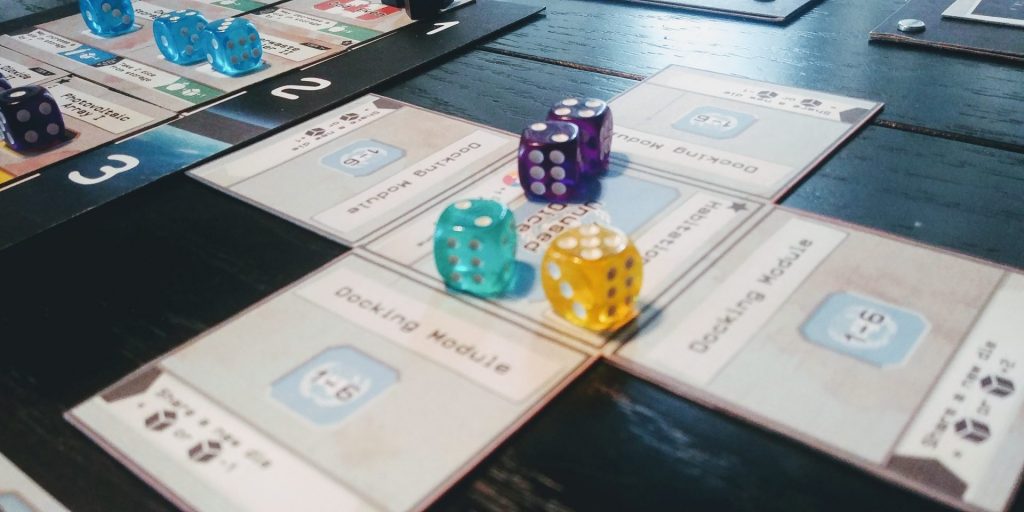
First, choose the countries for all four stations. Your choices are limited by which countries are set to the “A” switch, meaning they cover Climate and Power, and which are “B” countries that cover Nutrition and Oxygen. Next, gather the color-coded dice for each nation and complete the board setup by placing the station tiles around the Habitation Module. The rules do a good job walking you through the step-by-step instructions of how to seed the decks and build the tiers of available equipment. When the full setup is completed, Intrepid fills the table with theme – a space station with panels full of equipment.
How To Play
Essentially, you are trying to keep the lights on, the food growing, the air pumping, and the heater running all while being pelted by fast rocks and debris. Imagine space junk, meteor chunks, and solar winds punching holes in your superstructure and ripping equipment out by the bolts! Depending on your difficulty level, which you can tune by the number of mission cards in the main disaster deck, you will experience increasing cries of “Oh, no!”

Each nation takes its turn in order, rolling and placing dice to their best advantage. The dice-placement mechanism reminds me of Sagrada. In Intrepid, however, you are often stuck without enough dice to do everything you want, introducing tough choices. The various nations also have different dice manipulation rules, making this a collaborative optimization puzzle. Canada, for example, rolls many more dice than other nations but must place any odd-numbered results in “storage,” forcing the Canadian player to use their station tile abilities to pull dice from storage. How will you best power your systems and offset disaster? Will you use all your own dice, share them with other nations, or even ask them to share with you for the benefit of the spacecraft? You decide!

The station panels themselves are impressive wheels with grooves for moving cubes. Each turn you will adjust the wheel and the cube position based on your ever-changing environment, your constantly-failing equipment, and those omnipresent disasters, all to maintain the spacecraft. Failure to do so ends the game. Another component feature is that the station panel tiles are double-sided, allowing players to upgrade their effectiveness by spending resources to flip them over. There is no shortage of choice in Intrepid.
Kudos
I think a lot of things are working well in this game. The interconnected systems on the spacecraft force players to work together and discuss trade-offs. There was a healthy amount of discussion around which station needed which dice and why, and that was immensely satisfying. The decisions became a bit obvious over repeat plays since the starting mission uses the same equipment at setup. There could have been more options. Once you progress into the higher tiers of equipment, however, you see a nice branching of possibilities.
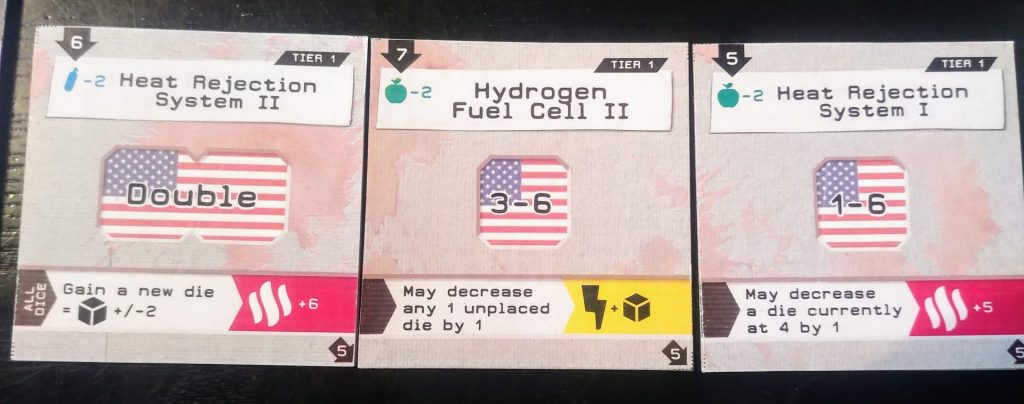
The nation-specific mechanisms are also a nice touch, specifically that they all seem to have different rules for dice manipulation. Because each player’s dice function in different ways, it helps mitigate any alpha gamer or quarterbacking issues that can creep into cooperative games. Generally, each player has enough decision space to manage their own station and you are counting on your fellow players to be on the ball. The teamwork in this game really shines through.

The components are great, too, both thematic and evocative. I enjoyed managing my own station, rolling my own color-coded dice, and upgrading equipment on a playing surface that really looked like a space station.
Quibbles
The learning curve is steep. There are a ton of moving parts that eventually become second nature. Once you know where to look and what to look for, the game has a smooth flow to it. However, it takes real work to get to that plateau. I do think Intrepid is worth the work, but be prepared to work a fair bit to learn the game.
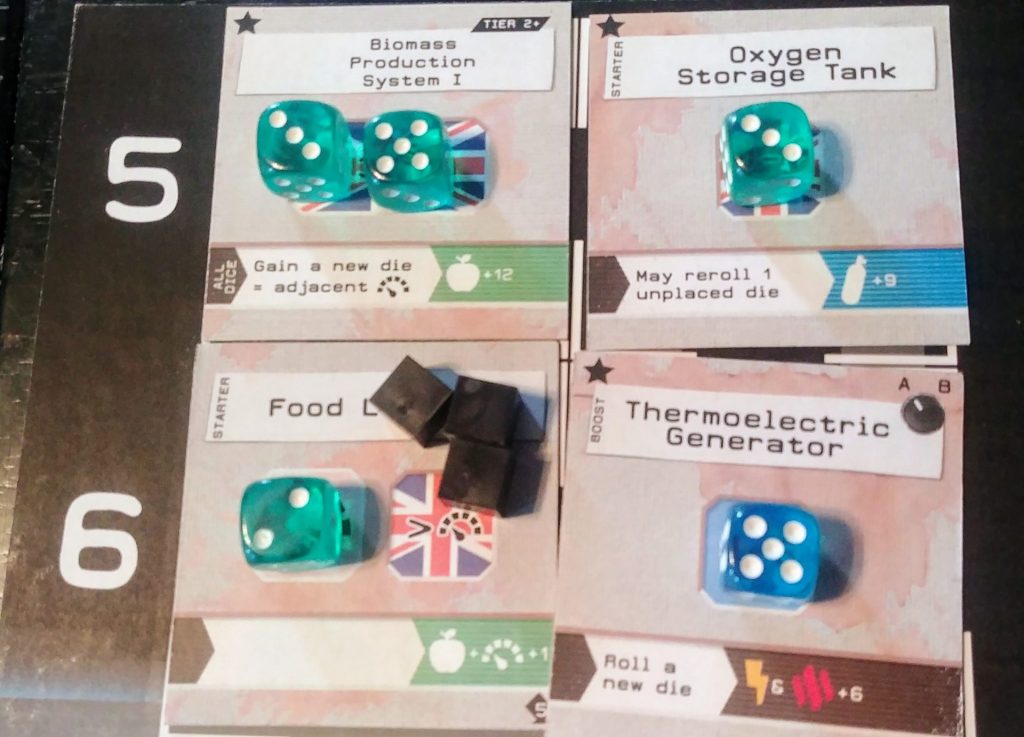
There are advanced station tiles (Tier 3 and 4) that seemed unlikely to ever enter the game. In our 4 games, we were only able to gather enough resources to purchase Tier 2 tiles because we routinely reached the victory conditions too quickly. I feel we barely scratched the surface of what was possible and those higher Tier tiles look awesome. I would have enjoyed playing with them.
The station panels also have spaces for incredibly high values of Climate, Power, etc. that we never got close to maxing out. I can only hope that in subsequent mission packs there will be higher starting points that will justify including those Tier 3 and 4 tiles. If not, it is a wasted opportunity.
It was tough to tweak the level of difficulty in a satisfying way. In just three plays, we transitioned from the game feeling “impossibly complex” (game 1) to “sort of challenging” (game 2) to “cakewalk” (game 3). When we reflected on it, the level of difficulty in the base default mission was too easy, but we were fine with that in our first two games because we were still learning the mechanisms. We should have increased the number of mission cards on game 3. The problem was we had no way to know that. Once we recognized the game was too easy, we were halfway through game 3, making it impractical to go back and reset. One simple way to increase difficulty is to play nations with more challenging mechanisms, like those of Brazil and Malaysia.
Wish List
I found the narrative arc unsatisfying. The missions are resource-based, wherein you build capacity in a certain resource (power, climate, etc.) over a period of time and you win. That primary mission of the game – survive – never changes, but the lack of variety in how you accomplish that wears thin on repeat plays. If there were story elements attached to the mission goals, it would help build a narrative and keep the game fresh. For example, if the mission were, “Boost your Power to 30 for 3 consecutive rounds,” it would be a simple addition to say “…to relay your coordinates to the rescue ship…” or “…to make contact with the alien culture within this perfect astronomical event…” or “…to burn to a higher orbit and avoid the meteor cloud.” Any of those provides a new context that would enhance the story of the game without changing mechanisms. You could also introduce other factors than resource gathering, such as ensuring specific equipment is activated to achieve victory. Variety in victory conditions will enhance replayability.
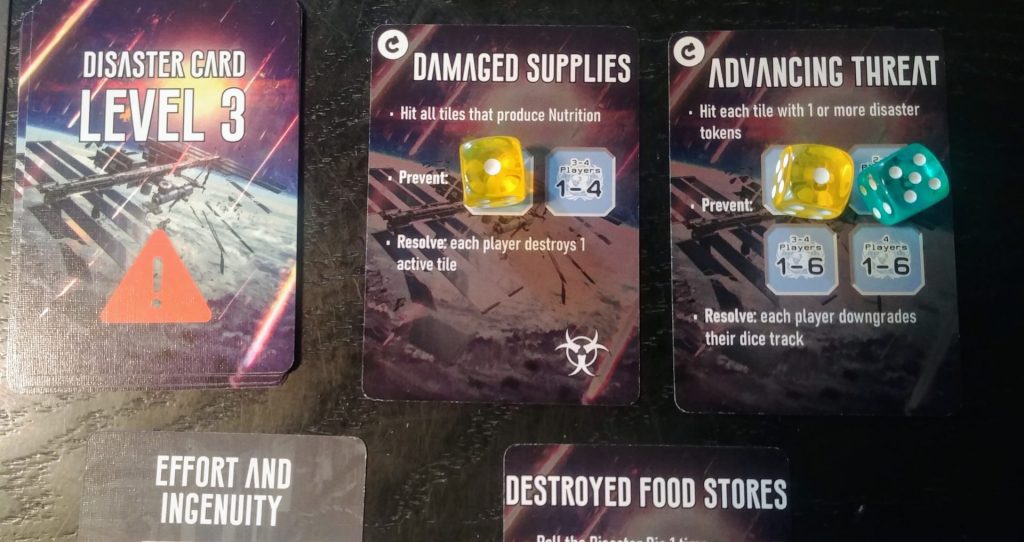
If there were further disaster complications that were not just broken technical systems, that would have been more compelling as well. If, for instance, rival countries like the Americans and Russians received a penalty when working together, that might have added some flavor. For that matter, if the stress of the crew needed to be managed like a system and old biases between nations began to show only as the station slipped deeper and deeper into the crisis, that would fit thematically and offer one more source of tension and chaos. The reverse is also possible, where national tensions are more of a hindrance at the outset and fall away as people recognize their only hope rests in trusting each other. I do think Intrepid’s mechanisms are simple enough to support additional complexity like this and it would be an exciting way to amp up the difficulty for experienced players.
Lastly, I wish there were a real-time element to the game. If the game featured a timer that forced players to use all their dice in a given time frame or else pull a new disaster, Intrepid would build in a thematic reason to encourage quicker play and introduce more tension. X-COM and Fuse come to mind as games where simple actions are made more challenging by introducing a timer. I think Intrepid could benefit from a frantic sense of real-time crisis response.
Final Observation
I liked Intrepid. The Kickstarter campaign will give the backers a chance to think critically about what the game offers and maybe make some recommendations on improvements before publishing. I encourage the designers to solicit this feedback and use it to explore the storytelling capabilities of the game engine. I believe the game has plenty of opportunity for quality story to emerge, not from tricked out components, but rather from emotional investment with thematic action in the game. I am excited to see what improvements the designers and publisher bring to the final version.


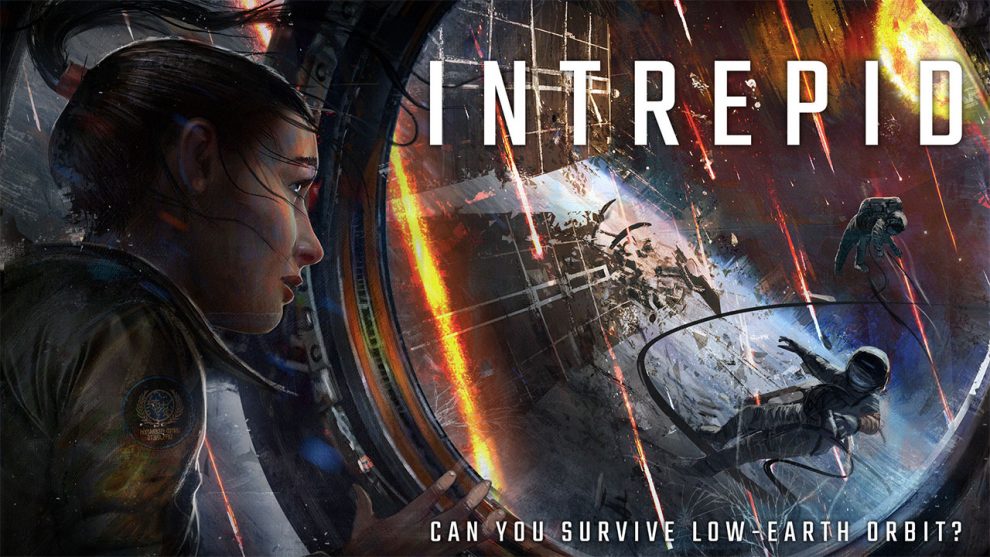


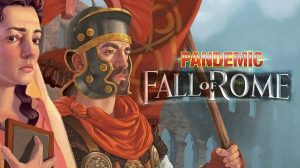





This is one I will have to think about!